 Image search results - "red" Image search results - "red" |

Entrance road to JRA (Japan Racing Association) Ritto Training Center. MAP
|
|

Saitama Stadium is a large soccer stadium built for the Soccer World Cup in 2002 and now home of the Urawa Reds. Way to Saitama Stadium 2002 from the train station.
|
|

Kachidoki (Victory) Bridge with race horse motif.
|
|

These photos were taken during the Vodafone Cup with the Urawa Reds vs. Manchester United on July 30, 2005. Over 58,000 fans attended.
|
|

Bridge sidewalk.
|
|

Vodafone Cup with the Urawa Reds vs. Manchester United on July 30, 2005.
|
|

Kachidoki Bridge
|
|

Stadium entry
|
|

Map of Ritto Training Center. Horse stables dominate the area.
|
|
|

Welcome to the JRA office, where the free 90 min. (1 pm - 2:30 pm) tour starts. (Reservations by phone required.)
|
|
|

24-hour strict security in place. Since 1969, the government-run Japan Racing Association (JRA) has trained jockeys and race horses in Ritto. It offers free tours of this large, impressive facility on Sunday afternoons and early Wednesday mornings.
|
|

Saitama Stadium 2002
|
|

Starting gate training ground.
|
|
|

Starting gates. The left gate has the largest width for beginner horses until they can get used to the narrow gates on the right. Some horses refuse to leave the gate.
|
|
|

What the horse sees inside the narrow starting gate.
|
|
|

Practice track
|
|
|

Practice horse track at JRA Ritto Training Center in Ritto.
|
|

Attendance number
|
|
|
|

Sea of Red
|
|

The training track consists of several different tracks with grass, dirt, or wood chips.
|
|
|

Horse stable model
|
|

Manchester United vs. Urawa Reds
|
|

Horse feed, mainly grain. No meats.
|
|
|

Swimming pool for horses. There is a circular pool and straight and narrow pools.
|
|
|

Horse stables, newly constructed.
|
|
|
|
|

Horse stables.
|
|
|
|
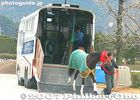
Unloaded a horse after a race. Horse trucks often arrived. One truck usually holds up to four horses.
|
|

Good save
|
|

Uphill training course with wood chips. 坂路調教馬場
|
|

Someone injured
|
|

Uphill training course with observation building. The wood chips are soft, making the horse less prone to injury.
|
|

Crowd heading for Urawa-misono Station on the Sai-no-Kuni Stadium Line. It was a stop and go process.
|
|

The dance is a prayer for a good harvest and to ward off bad luck. This dance was once performed by about 20 shrines along the Tamagawa River in Tokyo and Kawasaki. Now, only this shrine performs it in Tokyo. 天児屋根命(あめのこやねのみ�This god is called Amenokoyane-no-Mikoto (god of festivals).
天狗様「猿田彦命(さるたひこのみこと)」や、神事、祭りを司る神「天児屋根命(あめのこやねのみこと)」、山の幸の神「彦火火出見命(ひこほほでみのみこと)」など、それぞれの役どころを表現する個性豊かな神の舞を見せてくれる。
|
|

Inside the observation building's press room.
|
|

Getting nearer to the train station.
|
|

A small square area with a straw mat enclosed by a shimenawa sacred rope is the makeshift stage for the Negi-no-Mai Sacred Dance at Tenso Shrine.
|
|
|
|

A total of five gods are depicted in this sacred dance. Today, "Negi" refers to the rank of a Shinto priest. During the Edo Period, "Negi" referred to Shinto priests in general. 山の幸の神「彦火火出見命(ひこほほでみ�
|
|

Nice view of uphill training course. The wood chips, which eventually wear out, are replaced once a year.
|
|

This god is called Hikohohode-no-Mikoto which brings food from the mountains. Negi-no-Mai is nicknamed Dedenko-mai, in reference to the taiko drum beat ("dedenko").
|
|

View of track from press room.
|
|

This last god, called Oyamazumi-no-Mikoto, threw mochi rice cakes to everyone. He brings water, greenery, etc. from the mountains. 大山
|
|

Starting gate on training track.
|
|
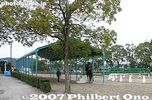
The tour includes a ride on a retired race horse.
|
|
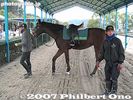
This one is named Meisho Ittetsu. メイショウ イッテツ
|
|
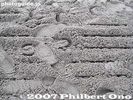
Hoof marks on sand.
|
|
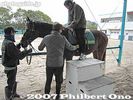
Horse ride.
|
|
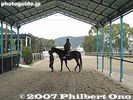
Horse ride with a guide guiding the horse.
|
|

No need to say giddy-up.
|
|
|
|
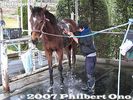
Washing a horse with warrm water.
|
|
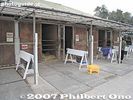
Horse stables.
|
|
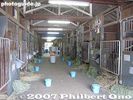
Horse stables.
|
|
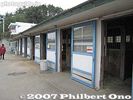
Horse stables.
|
|
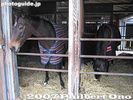
Horses in stable.
|
|

Unusual horse with a white face.
|
|

The left profile is brown.
|
|

Hi horsey!
|
|
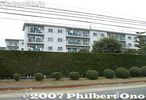
Staff living quarters
|
|

Free gift given at the end of the tour: Pen, stapler, and ruler set. Very interesting tour even though you don't see any horses running on the track. (That's Wednesday's early morning tour.)
|
|

Kentosai Sacred Dance
|
|
|
|

Shrine maidens perform Kentosai dance
|
|

Sacred rock where the god lives.
|
|
|
|
|
|
|
|

Eigenji Temple
|
|
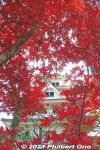
Red maples behind the main tower.
|
|
|
|
|
|

Built in 1888, the former Hokkaido Government Office Building is one of Hokkaido's most famous buildings at the heart of Sapporo. With its red brick walls, it stands out among Sapporo's more modern buildings.
|
|

The building was akin to Hokkaido's capitol where the governor's office was located. It was used for 80 years. Open 9 am - 5 pm, closed Dec. 29-Jan. 3. Free admission. Near Sapporo Station's south exit and visible from Ekimae-dori road.
|
|

Nicknamed "Akarenga Chosha" (Red Brick Government Building), a fire in 1909 gutted the interior, but the exterior was little damaged. The building was restored in 1911. 赤れんが庁舎
|
|

Most of the building materials, stones and wood, were procured from Hokkaido. The building is flanked by yaezakura cherry trees which bloom in early May.
|
|

Tulips also give a colorful touch to the grounds. In 1968, the building was restored to its original state, and it has been preserved since then. It has an American Neo-baroque style.
|
|

In March 1969, it was designated as an Important Cultural Property. Its 2.5 million bricks were made locally and laid in a French style.
|
|
|
|
|

The roof has chimney-like ventilation outlets.
|
|
|

Former Hokkaido Government Office Building and tulips, Sapporo
|
|

Former Hokkaido Government Office Building and yaezakura cherry blossoms, Sapporo
|
|

Adjacent pond and cherry blossoms
|
|
|

G8 Summit countdown sign
|
|

The interior of the Former Hokkaido Government Office Building is just as dignified as the exterior. This triple-arch staircase is what you first see when you enter the building.
|
|

Rear of the triple-arch staircase.
|
|

Going to the 2nd floor.
|
|

Most of the rooms open to the public are on the 2nd floor.
|
|

Staircase and G8 Summit sign
|
|

Second floor corridor.
|
|

On the right is the entrance to the former Governor's office
|
|

The second floor has several large rooms. This is the Hokkaido Archives where Hokkaido's historical documents and records are kept.
|
|

Cannon balls
|
|

Inside the former office of the Governor. There's a large conference table and the walls are decorated with portraits of past Hokkaido governors.
|
|

Portraits of past Hokkaido governors. The bottom row are the most recent governors.
|
|

A stately room. The governor's desk is in the right corner.
|
|

Governor's desk in the governor's former office.
|
|

Another room on the 2nd floor shows Hokkaido's international relations with sister states in Alberta, Canada; Massachusetts, USA; and Heilongjiang, China.
|
|

From Alberta, Canada
|
|

From Massachusetts, USA. The famous Dr. William Clark was from this US state.
|
|

Photos of international sister state exchanges.
|
|

Red bricks
|
|

Karafuto/Sakhalin Resource Library
|
|

Hokkaido History Gallery occupies another room on the 2nd floor.
|
|

Hokkaido History Gallery includes wildlife exhibit.
|
|

There's also the Northern Territories Room with exhibits clamoring for the return of the northern territories (Shikotan, Habomai, Etorofu). now occupied by Russia.
|
|
|

Petition for the return of the Northern Territories. As of late April 2008, over 80.3 million people signed the petition.
|
|

Poster for the return of the Northern Territories
|
|

Poster for the return of the Northern Territories. Her braided hair resembles the northern islands.
|
|

First floor corridor. Most of the rooms on the 1st floor are closed to the public.
|
|

Point Zero for Hokkaido's travel distances.
|
|

Along the road to the former government building are display panels about Hokkaido's hisotry. Here's one about the early foreigners in Hokkaido.
|
|
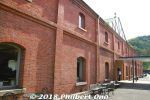
Opened in 2012, Maizuru Brick Park is a complex of 12 large brick buildings near the Japanese navy base. They were built from 1901 until the 1920s to store munitions (arsenal) for the Imperial Japanese Navy. Eight of the buildings are National Important Cultural Properties and a few of them have been renovated and opened to the public. This is the first building you enter, the Maizuru World Brick Museum (赤れんが博物館).
Hours 9:00 am–5:00 pm, closed Dec. 29–Jan. 1. 15-min. walk from JR Higashi-Maizuru Station (JR Maizuru Line and Obama Line). Parking available.
Map: https://goo.gl/maps/ZuFd1eXrNds
|
|
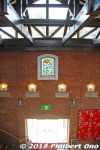
Inside the huge Maizuru World Brick Museum.
|
|
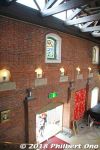
Very high brick wall.
|
|
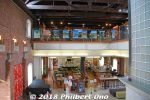
Inside the huge Maizuru World Brick Museum. It was used to store torpedoes made by munitions factories in Maizuru. Restaurant on the groundfloor, museum on the upper level.
|
|
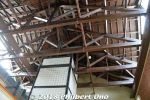
Ceiling of the huge Maizuru World Brick Museum.
|
|
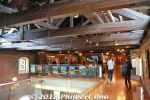
The museum is on the upper level.
|
|
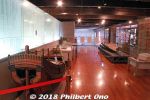
Maizuru World Brick Museum on the upper floor. Exhibits local historical artifacts. There's no English though.
|
|

Ancient dugout canoe found in Maizuru.
|
|
|
|
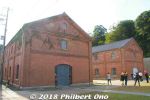
These brick buildings are not open to the public.Maizuru Brick Park, Kyoto Prefecture.
|
|
|
|
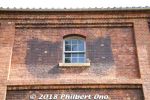
During World War II, the brick buildings were painted black to make them less noticeable. The black paint still remains here and there. Amazing that these buildings have survived. Maizuru's weapons factories and navy base got heavily bombed by American planes in July 1945, but not this arsenal.
|
|
|
|
|
|
|
|

Inside Brick Building No. 5 (赤れんが5号棟), the park's largest building. Built in 1918 to store torpedoes, depth charges, and mines. After the war, it was used by a warehouse company.Now used as an event hall and cafe space (cafe open only on weekends). It can be rented to hold exhibitions or events (concerts, weddings, etc.). It has been reinforced with these steel girders for earthquake resistance. National Important Cultural Property.
|
|
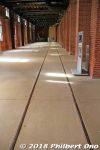
Brick Building No. 5 had rails.
|
|
|
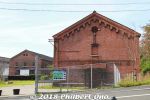
This part of the park had buildings owned by the Japanese government. Not open to the public.
|
|
|
|
|
|
|
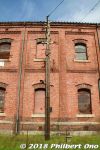
The brick park has been used as a backdrop in Japanese movies.
|
|
|
|
|
|
|
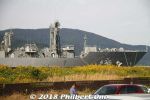
Maizuru Brick Park is right next to the Japan Maritime Self-Defense Force's Maizuru navy base.
|
|
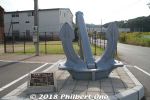
Old anchor for the Shirane destroyer that was retired in 2015.https://en.wikipedia.org/wiki/JDS_Shirane
|
|
|
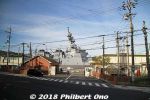
Japan Maritime Self-Defense Force's Maizuru navy base (舞鶴基地) where the Hyuga helicopter carrier, Aegis ship, and other navy ships are based.This base is in charge of maritime security along the Sea of Japan's coast from Yamaguchi to Aomori Prefectures.
|
|
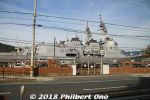
This is the Atago, a guided missile destroyer.
|
|

Little Shinto shrine and red maples.
|
|
|
|
|
|
|

I had a great autumn photo shoot this day at Tokugen-in.
|
|
|

In Sept. 2018, this front wall of Tokugen-in temple collapsed due to a strong typhoon.
|
|

I left the lakeside road and took a side trip to the center of Sobetsu town.
|
|

This river leads to Sobetsu Falls.
|
|

Passed by two small Shinto shrines...
|
|

Another red torii.
|
|
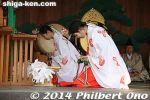
I was waiting for this. Sacred dances by shrine maidens who looked to be high school girls.
|
|
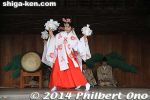
In the morning and early afternoon of January 1 and 2, shrine maidens perform sacred dances (初神楽) on the Noh stage.
|
|
|
|
|
|
|
|
|
|
|
|
|
|
|
|
|
|
|
|
|
|
|
|
|

Kaguraden stage where they performed sacred dances. They would dance on Jan. 1 and 2, in the morning and early afternoon.
|
|
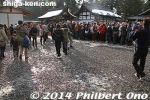
Most of the snow had melted.
|
|
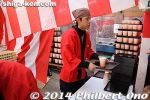
Amazake (sweet sake, non-alcoholic) for 300 yen/cup to warm you up.
|
|
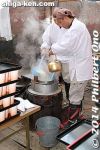
Preparing gallons upon gallons of amazake (sweet sake, non-alcoholic). 300 yen/cup.
|
|

Kushiro City Red-Crowned Crane Natural Park (Kushiro Japanese Crane Reserve) keeps red-crowned cranes (tancho 丹頂) for the public to see year-round. Kushiro is where the cranes can also be found in the wild.
|
|

Entrance to the park has this sign indicating how many years the park has been operating since Aug. 27, 1958. Visited in 2022, so it was 63 years. It also says the park currently has 14 cranes.
|
|
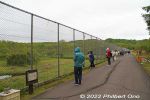
The park basically is marshland with fences keeping the cranes inside. Visitors could walk along the tall fence and see the cranes, usually in pairs.
|
|
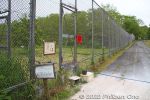
I walked all the way to the end and found this dead-end. This is also a bird sanctuary where they treat injured cranes. The park has done a lot to help preserve and multiply the cranes.
|
|
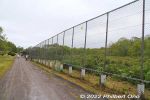
Walked back and checked every crane on display.
|
|
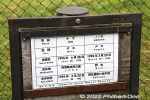
The cages also have signs indicating the names, birthdates, and birthplaces of the paired cranes.
|
|
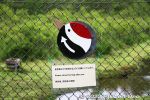
The fence also has a covered hole for taking pictures.
|
|

The fence also has quiz questions like "What's the difference between the male and female crane?" The answer is behind the sign.
|
|
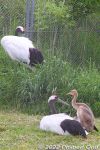
At Kushiro City Red-Crowned Crane Natural Park, we also saw a baby crane, about a month old. (Born in mid-May 2022.) Here he/she is with dad and mom
|
|
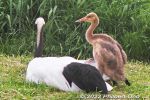
At Kushiro City Red-Crowned Crane Natural Park, baby red-crowned crane in mid-June 2022. That's the mother on the left.
|
|
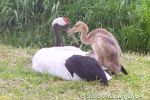
At Kushiro City Red-Crowned Crane Natural Park, baby red-crowned crane. You can see baby cranes at the park from April to June.
|
|
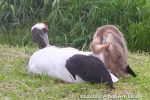
At Kushiro City Red-Crowned Crane Natural Park, baby red-crowned crane in mid-June 2022.
|
|
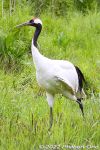
Red-crowned crane, Kushiro City Red-Crowned Crane Natural Park, Hokkaido.
|
|
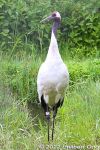
Red-crowned crane, Kushiro City Red-Crowned Crane Natural Park, Hokkaido.
|
|
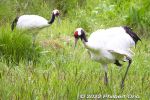
Red-crowned cranes, Kushiro City Red-Crowned Crane Natural Park, Hokkaido.
|
|
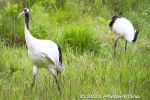
Red-crowned cranes, Kushiro City Red-Crowned Crane Natural Park (Kushiro Japanese Crane Reserve).
|
|
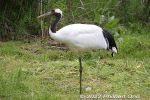
Red-crowned crane, Kushiro City Red-Crowned Crane Natural Park (Kushiro Japanese Crane Reserve).
|
|
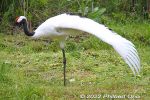
Red-crowned crane, Kushiro City Red-Crowned Crane Natural Park (Kushiro Japanese Crane Reserve).
|
|
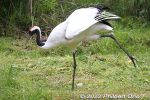
Red-crowned crane, Kushiro City Red-Crowned Crane Natural Park (Kushiro Japanese Crane Reserve).
|
|
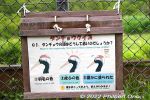
"Why do they have a red crown?"
|
|
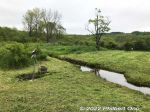
Kushiro Japanese Crane Reserve
|
|
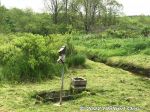
Kushiro Japanese Crane Reserve crane feeder. They also feed the cranes in the morning. It would be neat to see if you're there.
|
|
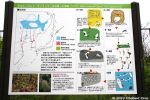
Life cycle of Japanese red-crowned cranes. For wildlife photographers, the most popular time is Jan.-March in winter when the cranes dance in the snow for their mating ritual.Asian mainland has about 1,600 red-crowned cranes, and Japan (eastern Hokkaido) has 1,200 cranes.
|
|
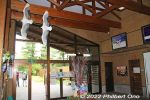
The park also has a small crane museum.
|
|
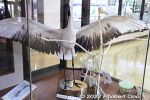
Crane skeleton.
|
|
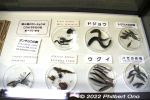
What cranes eat. Small fish, insects, and more.
|
|

Baby cranes grow very quickly. Left one is 39 days old, middle is 5 days old. They reach adult size in 3 months. Their brown feathers also turn black and white.
|
|
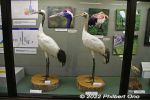
Adult males, fully grown on the left and 6 months old on the right still with brown feathers.
|
|
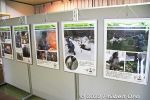
Panel displays explaining about the cranes and problems.
|
|
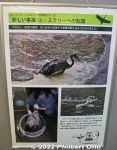
Cleaning up a crane that fell into a slurry pool.
|
|
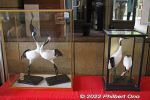
Crane dolls.
|
|
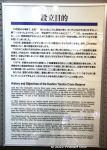
About the Kushiro Japanese Red-Crowned Crane Reserve.
|
|

History of the Kushiro Japanese Crane Reserve.
|
|
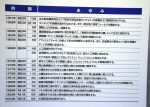
History of the Kushiro Japanese Crane Reserve in Japanese.
|
|

Opened in 1914, Tokyo Station is Japan's main train station and has been undergoing major renovations. The red brick station building on the Marunouchi side has been restored with the original roof domes.
|
|

Tokyo Station unveiled its fully-restored Marunouchi building on Oct. 1, 2012 after taking several years. To appreciate the extent of this splendid restoration, I've included photos of what it looked like before.
|
|
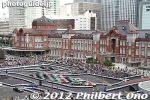
Tokyo Station has two main entrances/exits: Marunouchi and Yaesu. Both sides are undergoing a major transformation.
|
|
|
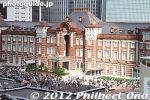
Tokyo Station's Marunouchi North entrance in Oct. 2012. Lot of people were there gazing and taking pictures of the restored building.
|
|
|
|
|

Old Tokyo Station, Marunouchi side. On the left end is the North Entrance under a dome roof, and on the right end is the South Entrance also under a dome roof. Both dome roofs were damaged during World War II, and were repaired with slat-style roofs.
|
|
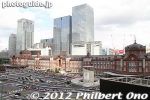
The new Tokyo Station with original domes restored. See more before and after photos below.
|
|

Tokyo Station, Marunouchi side. This side faces the Imperial Palace and the Otemachi business district.
|
|
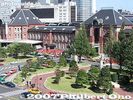
Tokyo Station, red brick building. The large center entrance also has a dome, but it is not used. The center entrance for the public is off to the left side (very small). 赤レンガビル
|
|

Tokyo Station, Marunouchi North Entrance dome in 2007.
|
|
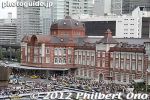
Tokyo Station, Marunouchi North Entrance dome in Oct. 2012.
|
|
|
|